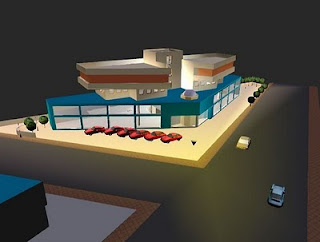Αρχιτέκτων ΕΜΠ – Πρόεδρος ΣΑΔΑΣ –ΠΕΑ
O κλάδος των Αρχιτεκτόνων επηρεάζεται από την δυσχερή οικονομική συγκυρία ίσως πιο έντονα και άμεσα από οποιαδήποτε άλλη ειδικότητα με δίπλωμα Πολυτεχνείου. Είναι προφανές, πως σε περίοδο περικοπής εξόδων, ανασύνταξης και φοβικότητας, τόσο ο Έλληνας ιδιώτης, όσο και το δημόσιο θα ξεκινήσουν τις περικοπές από τις γενικευμένα και αφελώς θεωρούμενες ως «διακοσμητικές» ή «περιττές», υπηρεσίες της Αρχιτεκτονικής και του Αρχιτέκτονα. Και αυτό, γιατί η ελληνική πολιτική ανέβαλλε συστηματικά τα τελευταία χρόνια την άσκηση πολιτικής γης τόσο στην πόλη όσο και στην περιφέρεια και κατ’ επέκταση ανέβαλλε την ανάδειξη του αρχιτεκτονικού και πολεοδομικού σχεδιασμού – design ως τη μοναδική οδό συνολικής επίλυσης σύνθετων προβλημάτων. Όταν ο εγχώριος αρχιτεκτονικός σχεδιασμός ως θεωρητικό υπόβαθρο, ως αυστηρή εφαρμογή αλλά και ως κοινωνική πεποίθηση είναι ανύπαρκτος, στα πλαίσια μιας ΕΕ που σχεδιάζει με ακραία μεθοδικό τρόπο, είναι μοιραίο οι Έλληνες αρχιτέκτονες να βρίσκονται αυτή τη στιγμή στο μάτι του κυκλώνα.
Οι μελέτες είτε παγώνουν, είτε οργανώνονται βάσει ενός ελάχιστου και πλασματικού προϋπολογισμού. Οι νέοι –μέχρι σήμερα- εργαζόμενοι με δελτίο παροχής (κατι μεταξύ ελεύθερης συνεργασίας και υπαλληλικής σχέσης), αρχιτέκτονες- είναι οι πρώτοι που απομακρύνονται ευγενικά από τα μεγάλα αλλά και τα μικρά γραφεία.
Η έκρηξη της ανεργίας στις ηλικίες μεταξύ 25 και 35 είναι απελπιστική. Οι αιτήσεις για εγχώριες μεταπτυχιακές σπουδές πολλαπλασιάζονται, ενώ ταυτόχρονα αναδύονται οι αγγελίες για νέες θέσεις γραμματέων « με βασικές γνώσεις Cad». Τα ασφάλιστρα του «Τσμέδε» παραμένουν απαγορευτικά υψηλά και τα επωμίζονται οι γονείς, οι οποίοι κατά κανόνα συνεχίζουν να εμπιστεύονται και να προσβλέπουν στην δοκιμαζόμενη κοινωνική ασφάλιση.
Οι νέοι αρχιτέκτονες, επιδεικτικά αποστρέφονται την μορφή άσκησης του επαγγέλματος στην Ελλάδα, και επιλέγουν να αναζητήσουν μια πιο υποσχόμενη ακαδημαϊκή πορεία στα προβεβλημένα πανεπιστήμια της Ευρώπης και της Αμερικής. Οι υπόλοιποι αρκούνται σε μια «βουτιά στην ελληνική πραγματικότητα». Καθίστανται δηλαδή προσωρινά απασχολούμενοι σε ευκαιριακά projects μικρών και μεγάλων γραφείων ή στρέφονται προς επιδοτήσεις εξοπλισμών για νέους επαγγελματικούς χώρους, χρεωνόμενοι, ακολουθώντας εξαιρετικά ριψοκίνδυνα business plans.
Τον τελευταίο καιρό, μέσω των προκηρύξεων κάποιων διαγωνισμών και των εξαγγελιών του «Αθήνα 2014», διαγράφεται στο βάθος μια κάποια ελπίδα σχετικά με την συστηματοποίηση της συμμετοχής των αρχιτεκτόνων στα δημόσια έργα. Αναμένεται η σαφής διατύπωση αυτής της αρχιτεκτονικής συμμετοχής με οριστικοποίηση των χρονοδιαγραμμάτων, των διαγωνισμών, των αρχιτεκτονικών κατευθύνσεων, έτσι ώστε το «Αθήνα 2014» να αποτελέσει μια συγκεκριμένη, δημιουργική και αναπτυξιακή ευκαιρία για τον Κλάδο συνολικά, και όχι μια ευκαιρία για αυτοκαταστροφικές οικονομικά, φοιτητικού τύπου συμμετοχές σε προτάσεις και διαγωνισμούς χωρίς κίνητρα.
Γιατί, η οργάνωση και η «Λύσεις » που εκπορεύονται από το δημόσιο τομέα, είναι αυτές που θα δείξουν το δρόμο και θα δώσουν την ώθηση στον ιδιωτικό. Το 11ο Συνέδριο του ΣΑΔΑΣ –ΠΕΑ που θα πραγματοποιηθεί τον Μάρτιο του 2011, ευελπιστούμε να αποτελέσει ενα νέο σταθμό - ξεκίνημα για τον κλάδο των Αρχιτεκτόνων και το σχεδιασμό στην Ελλάδα γενικότερα.

